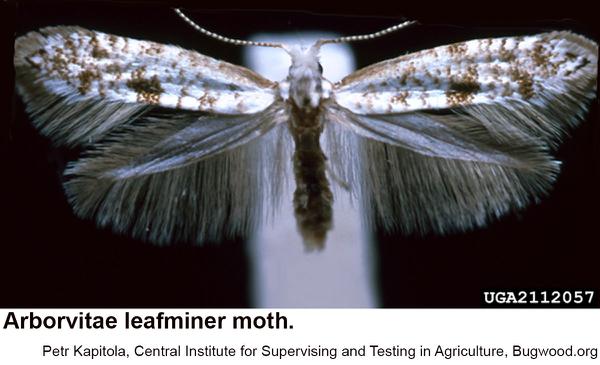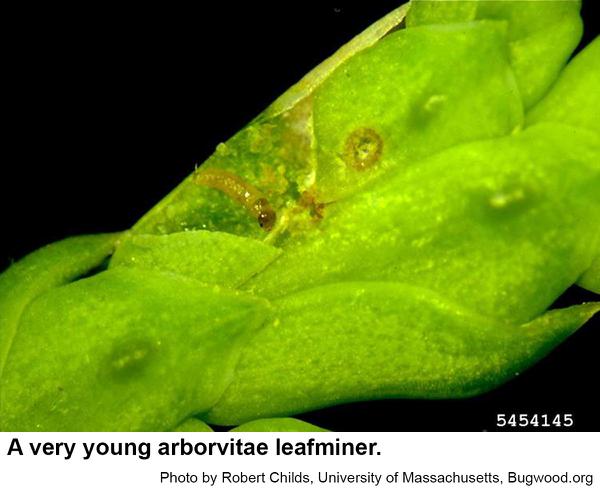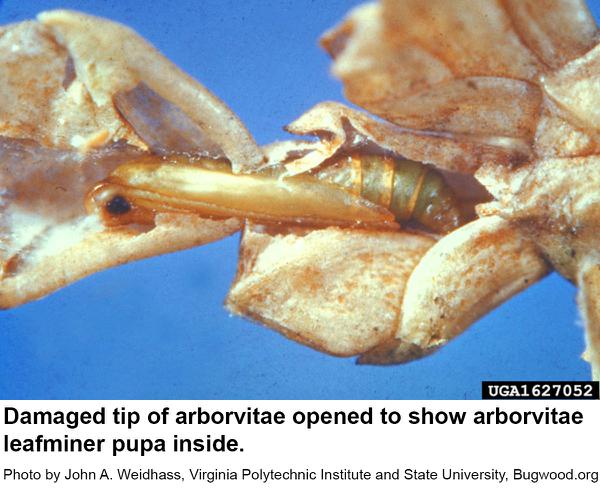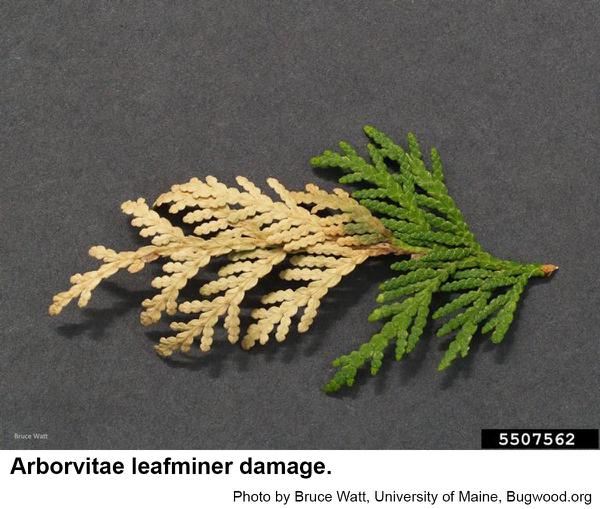Description and Biology
The arborvitae leafminer, Argyresthia thuiella, is a small (up to about ¼ inch long), green (sometimes with a reddish tinge), or brownish caterpillar with a dark brown or black head and a dark spot just behind the head (the cervical shield). Its 1/8 inch long pupa is greenish but turns brownish-red as it matures inside the mined leaf. The tail segment has a group of six to eight short, stout hooks called the cremaster. Adults are small (about 1/8 inch long), light gray moths with brown and black spots and slender antennae. The legs and abdomen are light brown. Eggs are tiny and almond shaped with wrinkled sculpturing on one end. Eggs are pinkish at first but turn darker as the embryo inside matures. Nearly fully grown arborvitae leafminers overwinter in mined foliage. Mature caterpillar present from April to June. The adult is a very small moth that emerges to lay eggs in May and June. A female may oviposit for 4 or 5 weeks. Most of the eggs are laid around the first of June. Newly hatched larvae bore into the leaves and feed for the rest of the season. Arborvitae leafminers overwinter as larvae in the mined leaves. From March to May these leafminers pupate in the new portion of the mine after an exit hole has been chewed. Pupae face the exit hole. New moths appear 3 to 5 weeks later in late spring or throughout the summer. After 2 or 3 days, females deposit eggs in the axils of branchlets or along leaf margins. The larvae mine from the tips of branchlets toward the bases and allow the frass to collect in the tunnels until winter. When mining is resumed the following spring, the frass is expelled from the mine. Larvae sometimes leave old mines and begin new ones.
Host Plants
The arborvitae leafminer apparently attacks all varieties of arborvitae (northern white cedar) but seems to prefer American pyramidal, globe, and golden arborvitae (about in that order). It may also attack juniper. Mined leaves turn yellowish or whitish and detract from the appearance of infested arborvitae. The tips may die out completely. At times, whole shrubs may turn brown from their feeding. Heavily damaged leaves may drop from the plant prematurely. In extreme cases a heavily infested plant may be killed.
Residential Recommendations
At least 26 species of parasitic wasps have been reared from infected arborvitae leafminers. Doing nothing should allow these parasites to reduce the population of leafminers naturally. If more rapid suppression is desired, shake the foliage in June or July to see if the moths fly around the shrubs. Spraying with a pyrethroid insecticide labeled for residential landscape use should help control these adults. When used as directed, pyrethroids are very toxic to insects but are not particularly hazardous to humans and pets (other than fish-avoid using pyrethroids around pools, ponds, and streams). Later in the season, try pruning out dead tips. Those clippings should be destroyed to prevent another generation of moths from emerging the following spring. Systemic insecticides such as imidacloprid are also recommended for control.
References
- Arborvitae Leaf Miner, Argyresthia thuiella Packard. Hanson, T., and E. B. Walker. 2015 (update). Forest Pests: Insects, Diseases & Other Damage Agents, Forest Pests, www.forestpests.org.
- Arborvitae Leafminer. Childs, R. 2011 (revised). UMassAmherst Center for Agriculture, Food and the Environment.
- Arborvitae Leafminer In Insect and Related Pests of Shrubs. Baker, J. R. 1980. NC Cooperative Extension Service Publication number AG-189. 199 pp.
- Arborvitae Leafminer. Krischik, V. and J. Davidson. No Date. IPM of Midwest Landscapes. 64. Pests of Trees and Shrubs.
- Caterpillars on the Foliage of Conifers in the Northeastern United States (revised). Anonymous. 2011. Forest Health Technology Enterprise Team.
- Extension Plant Pathology Publications and Factsheets
- Horticultural Science Publications
- North Carolina Agricultural Chemicals Manual
For assistance with a specific problem, contact your local N.C. Cooperative Extension Center
This Factsheet has not been peer reviewed.
Publication date: Sept. 23, 2016
Reviewed/Revised: June 30, 2021
Recommendations for the use of agricultural chemicals are included in this publication as a convenience to the reader. The use of brand names and any mention or listing of commercial products or services in this publication does not imply endorsement by NC State University or N.C. A&T State University nor discrimination against similar products or services not mentioned. Individuals who use agricultural chemicals are responsible for ensuring that the intended use complies with current regulations and conforms to the product label. Be sure to obtain current information about usage regulations and examine a current product label before applying any chemical. For assistance, contact your local N.C. Cooperative Extension county center.
N.C. Cooperative Extension prohibits discrimination and harassment regardless of age, color, disability, family and marital status, gender identity, national origin, political beliefs, race, religion, sex (including pregnancy), sexual orientation and veteran status.

.jpg)


.jpg)

